Collect requirements process is the second process of scope management knowledge area. In order to define the scope, the requirements of the stakeholders must be collected first. The main purpose of the collect requirements process is gathering stakeholder requirements in a project.
Attend our 100% Online & Self-Paced One-Hour Free PMP Training.
Before going into the details of collect requirements process and collect requirements process techniques, let’s look at the definition of PMP scope management according to the PMP project management course: Scope Management draws the boundaries of a project and it also shows what will be delivered during Project Closure process group.
What are the Stakeholder Requirements?
Before listing fifteen collect requirements process tools and techniques, let’s describe what is a requirement. In the PMP exam training, requirements are described as “what stakeholders expect from a project, or from the product of the project”. Requirements of the project stakeholders must be gathered in the project and managed properly. After requirements are finalized, these must be included in the scope and tracked throughout the project. Also, how requirements are met with the project deliverables must be demonstrated to the project stakeholders to complete a project successfully.
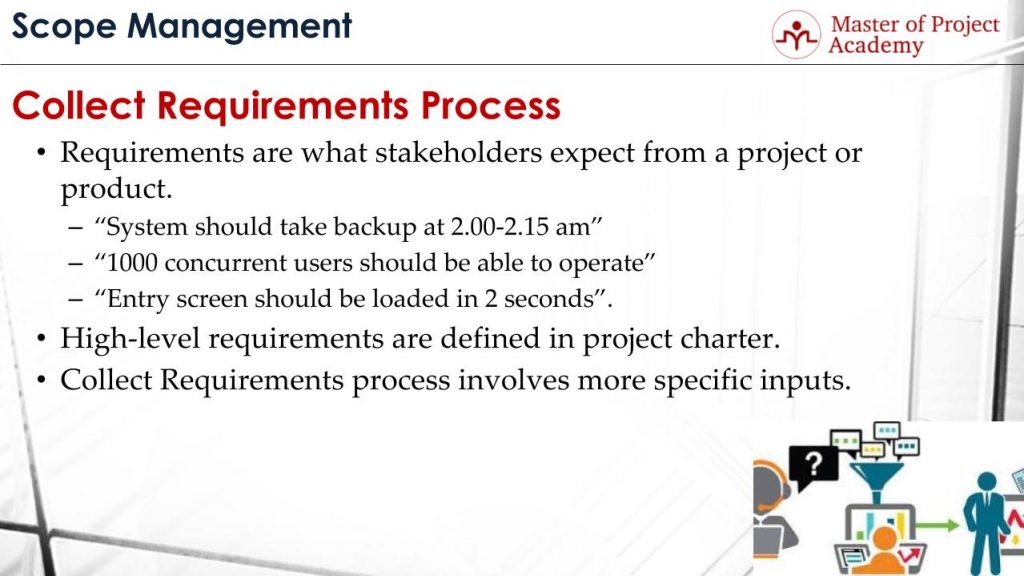
Now, let’s go over some sample project requirements. Let’s consider an e-commerce shopping website example:
- One of the requirements can be System should take backup at 2:00 to 2:15 am at night. Because it is expected to get the lowest traffic at night on a website, and a stakeholder that will be related to the operations of this site can be asking for this requirement.
- Another requirement can be 1000 concurrent users should be able to operate on the website without any service degradation. This can be a requirement of the capacity manager. Based on the anticipated traffic, it might be required to support 1000 users concurrently on the website.
- And the last requirement sample can be Entry screen should be loaded in 2 seconds. The speed of a website is a crucial factor in the eyes of today’s customer. Therefore, loading time of a website is a critical factor that is affecting customer experience and this can be a requirement from the customer service team.
Note that, there will be several requirements in a project and we just listed three of them here to illustrate requirements of a project in your mind.
High-level requirements of a project are defined in the project charter. The project charter is created in the project initiation. As long as high-level requirements of a project are determined, these are included in the project charter. But, new requirements will be received later and requirements will be gathered and finalized during planning. Therefore, collect requirements process involves more specific inputs.
15 Tools & Techniques
Collecting Requirements is a crucial activity in project management. Because requirements of a project define the project scope. And any weakness in requirements management will cause scope issues respectively.
In order to collect requirements from project stakeholders, several tools and techniques are used. Let’s see the 15 techniques to collect requirements process one by one.
Technique #1: Interviewing
Interviewing is the first collect requirements technique. It can be done through a meeting, through a phone call or through e-mails. In this collect requirements technique Project Manager interviews the stakeholders to get their requirements. There can be a checklist, a list of questions or project manager can just ask the stakeholders to express their expectations from the project in a free form. Project manager notes down and stores the requirements received from the project stakeholders.
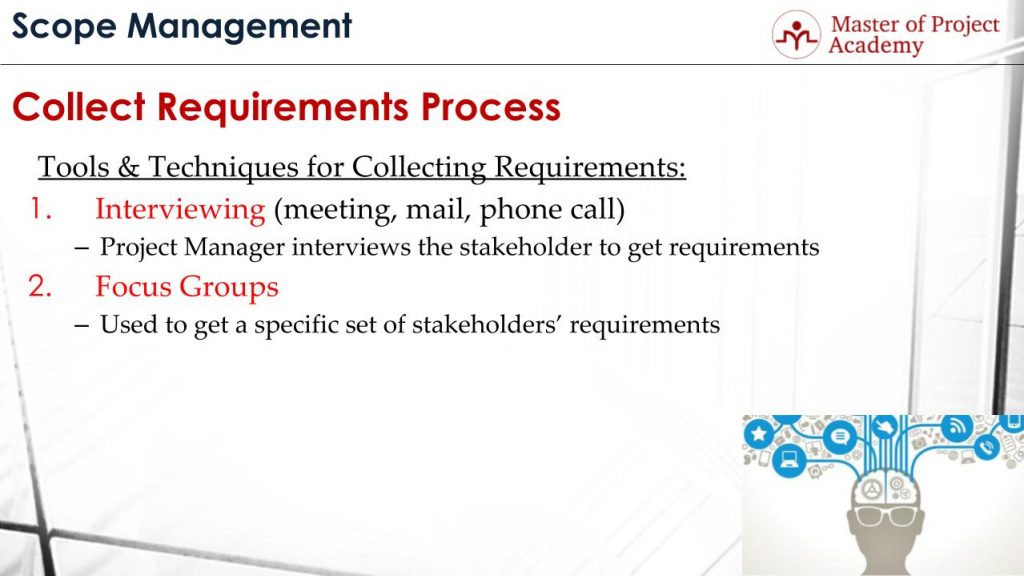
Technique #2: Focus Groups.
Focus group is the second collect requirements technique and it is used to get a specific set of stakeholders’ requirements. For instance, you can organize a meeting with executive directors in your company to get their requirements first, and then organize a separate meeting with the functional managers to get their requirements.
Technique #3: Facilitated Workshops
In facilitated workshops, stakeholders with different perspectives are brought together. Let’s consider that you will manage a software project. You can bring analysts, software developers, test engineers, operation team, and customer together. Each group of project stakeholders will look to the project from their perspective and express their requirements. For instance, operation team will consider operational aspects, the customer will express business requirements, software developers will state the technical requirements.
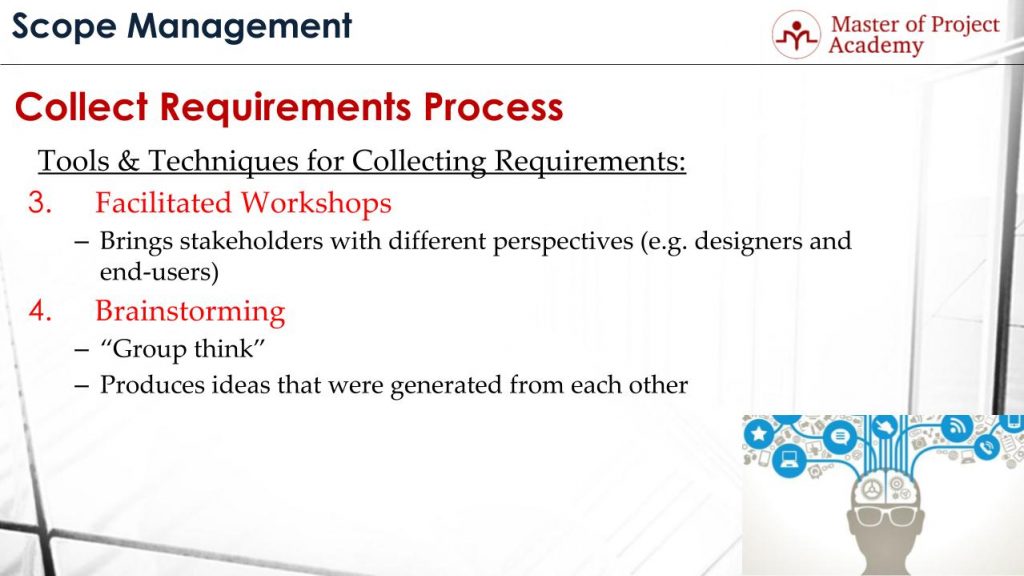
Collect Requirements Process Technique #4: Brainstorming
Fourth collect requirements process technique is called Brainstorming and it is actually a Group Think. Because several people come together to list requirements of a project. And during the meeting, new ideas are generated from existing ideas. This helps to identify new requirements.
Collect Requirements Process Technique #5: Nominal Group Technique
This is actually a collect requirements process technique to prioritize ideas rather than generating new requirements. In nominal group technique, meeting participants rank the most successful ideas. This helps to focus on more valuable or prioritized ideas first in generating project requirements. Nominal group technique is usually used in brainstorming meetings. Because there will be several ideas coming from several stakeholders. If these are not ranked, focusing the stakeholders on a narrower topic and finalizing requirements will be tough.
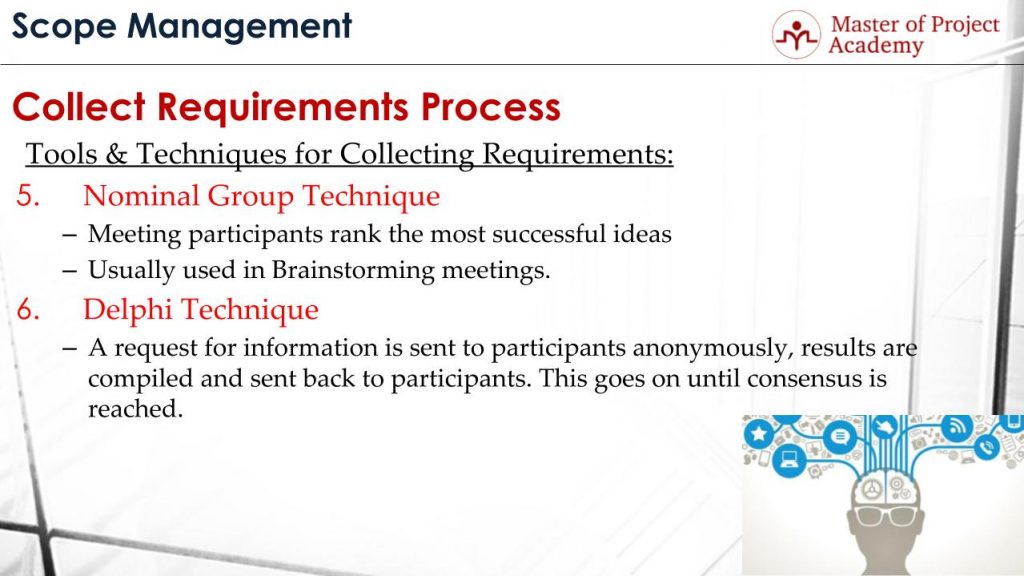
Collect Requirements Process Technique #6: Delphi Technique
In the sixth collect requirements process technique which is called Delphi technique, a request for information is sent to project stakeholders anonymously. Stakeholders list their requirements individually and send back these requirements. Then, these results and collected results are sent again to project stakeholders. This technique to collect requirements anonymously is mainly for not affecting stakeholders’ decision based on the owner of the requirement. For instance, if a senior director and functional manager are sending their requirements, if the functional manager would know the requirements of the senior director, because of the hierarchical relationship, he can be affected by the requirements of the senior director. Resending requirements and getting back feedback goes until a consensus is reached among the stakeholders.
Collect Requirements Process Technique #7: Idea/Mind Mapping
This collect requirements process technique is actually a diagram of ideas or notes to help generate, classify, or record information. Ideas or parts of a project are drawn on the table, and new ideas or parts that can be in the project are generated.
Let’s go over Idea/Mind Mapping collect requirements process technique over an example. An airplane will consist of parts such as wings, cockpit area, tail, and passenger cabin. And when thinking about what can be in the passenger area, we can list toilets, seats, serving kitchen area etc.
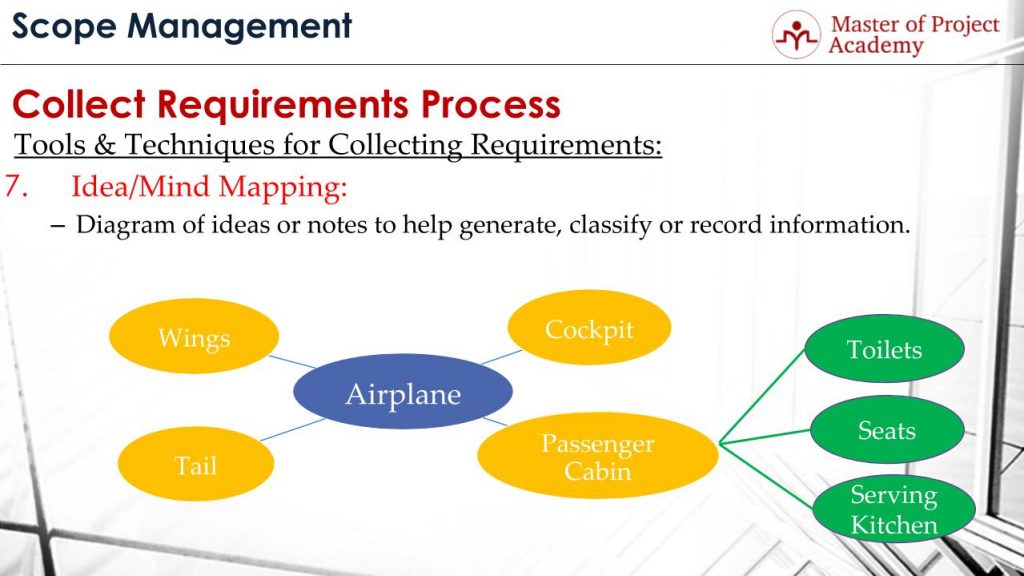
Collect Requirements Process Technique #8: Affinity Diagrams
In collect requirements process technique called affinity diagrams, ideas generated from any other requirements gathering techniques are sorted into groups by similarities. For instance, requirements for cockpit area, requirements about passenger area, requirements about tails etc. can be grouped.
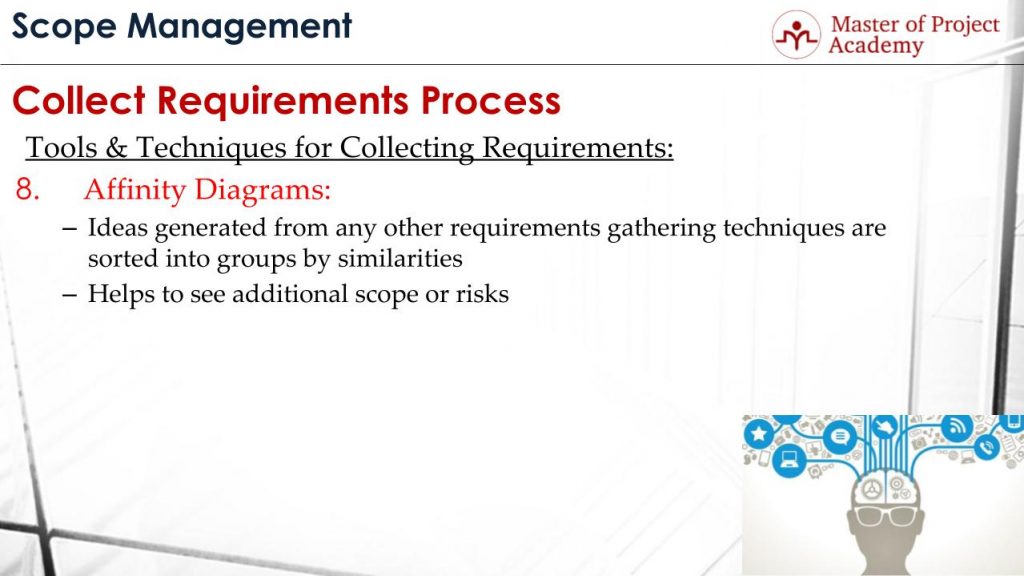
Affinity Diagrams collect requirements process technique helps to see additional scope or risks. Because similar requirements will be seen together under the same group which will ease to see if there will be any more requirements or if there are any further risks regarding a group of requirements.
As you see, requirements or parts for each area of an airplane are listed in the figure below. When we see this figure, you can think about several other requirements for each group and grouping helps to think about these new requirements. For instance, a new requirement for the passenger cabin can be the tray tables.
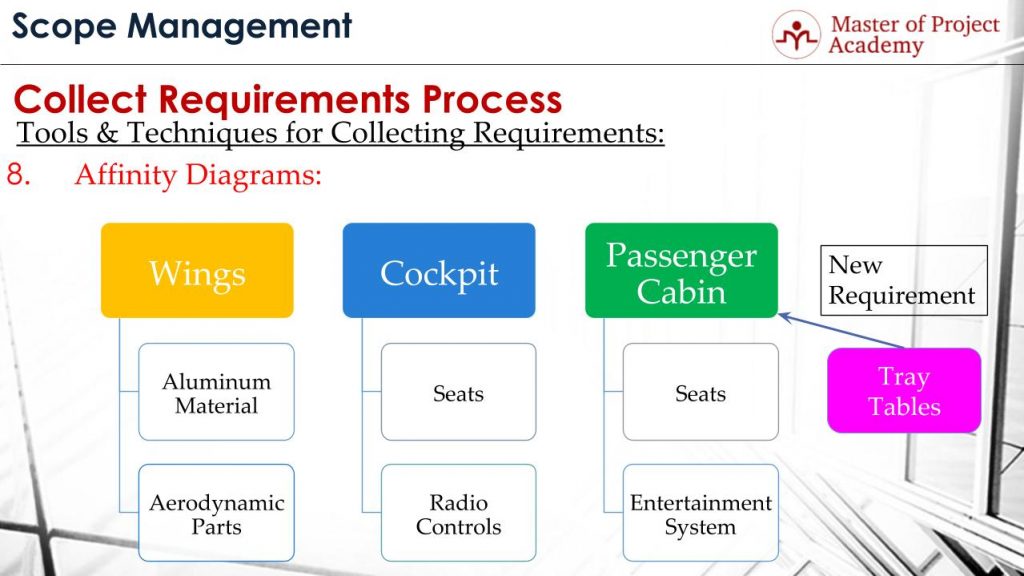
Collect Requirements Process Technique #9: Questionnaires and Surveys
Ninth technique for collect requirements process is Questionnaires and Surveys and it is used for large groups where there are several stakeholders that you have to collect their requirements. Let’s consider that you have more than 200 stakeholders in a project that you need to contact and collect their requirements. Organizing a meeting or interviewing one-by-one will take a long time to finalize requirements. In this case, to prepare a questionnaire and survey and to collect requirements of several stakeholders will be easier with this technique.
Collect Requirements Process Technique #10: Observation
In the collect requirements process technique called observation, a potential user of the product is watched to identify requirements. For instance, in order to determine the user experience or most used features of an e-commerce shopping website, a consumer can be observed. Based on the steps that the consumer will take, project requirements can be identified or prioritized.
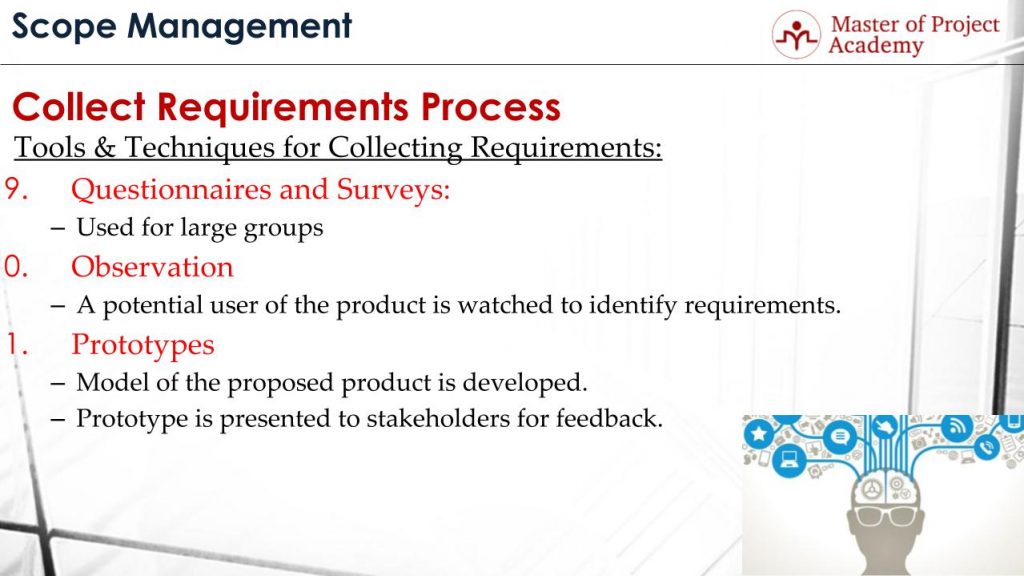
Collect Requirements Process Technique #11: Prototypes
In this collect requirements process technique, a model of the proposed product is developed and then this model is presented to stakeholders for feedback. Let’s consider that a smartphone manufacturer will produce a new smartphone. In order to get feedback from stakeholders, features and functionalities from existing smartphones can be combined in a prototype. And this prototype can be presented to a set of consumers to get their feedback.
Collect Requirements Process Technique #12: Group Decision Making
In this collect requirements process technique, several opinions are evaluated in a group. There can be several requirements about a project and each stakeholder might express their own requirements. In the end, these must be evaluated whether these requirements will be in the project scope.
There are four approaches in Group Decision Making technique:
- Unanimity: In this case, everyone agrees with the idea that is being evaluated. So it is qualified to be in the final list.
- Majority: In this case, more than 50% of the group agrees on a requirement. In order to put a requirement on the final scope, if this approach is applied, more than half of the group must agree on it.
- Plurality: In this case, largest block in a group agrees on a requirement. For instance, if 40% of the group agrees, 30% of the group disagrees and 30% of the group does not have a decision since the largest part of the group agrees, the requirement will be qualified to be in the scope.
- Dictatorship: In this approach, one individual makes the decision for the group on a requirement. For instance, if the Senior Director is in the group and if he has the privilege to approve or disapprove a requirement, regardless of what other participants think, Senior Director’s decision will determine whether the requirement will be in the project scope.
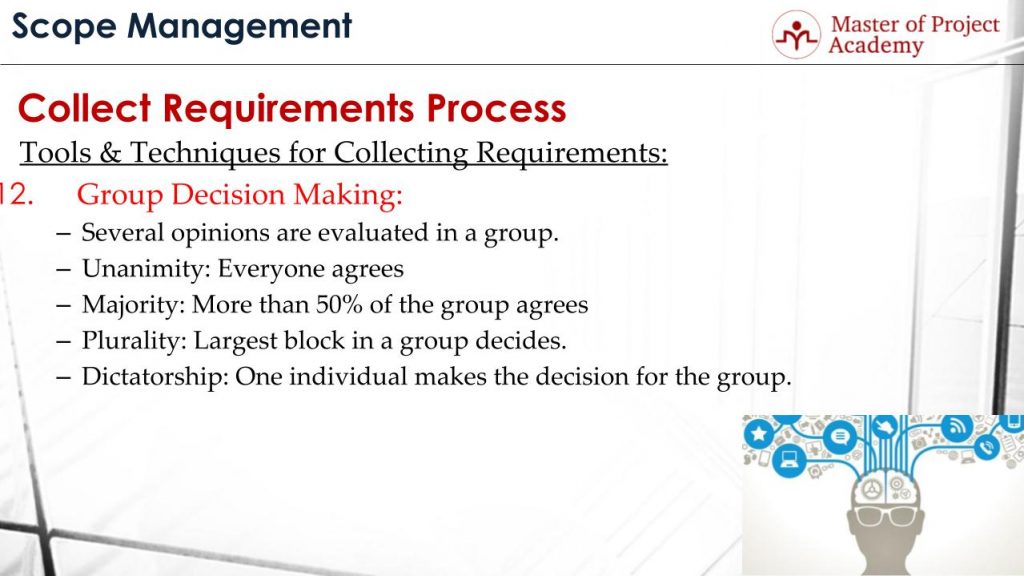
Collect Requirements Process Technique #13: Benchmarking
In the thirteenth collect requirements process technique called benchmarking, a company compares its actual or planned practices, to those of comparable organizations to identify best practices. Because a company must be profitable to survive in the market. And in order to be profitable, it has to know the market dynamics, competitors in the market, its strengths and weaknesses against competitors. And projects must be initiated to take a position in the market accordingly. For instance, if Samsung benchmarks its test processes with the Apple’s, this is an example of benchmarking. Because they are both in the smartphone and tablet market and they are competitors.
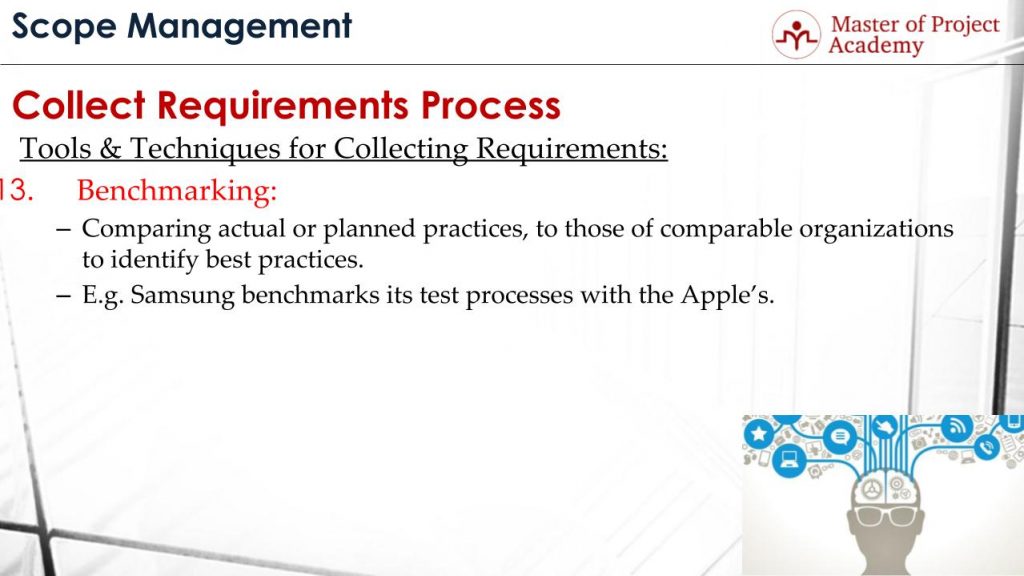
Collect Requirements Process Technique #14: Context Diagrams
Fourteenth collect requirements process technique Context Diagrams. They actually give an example of a scope model. They visualize how a system; function or product will work. By this way, scope becomes more understandable. Context Diagrams define how other users and systems interact with it. Context diagrams show steps that the customer need to do, steps that will be done by the process, actions that will be completed by the product, outputs of the system etc.
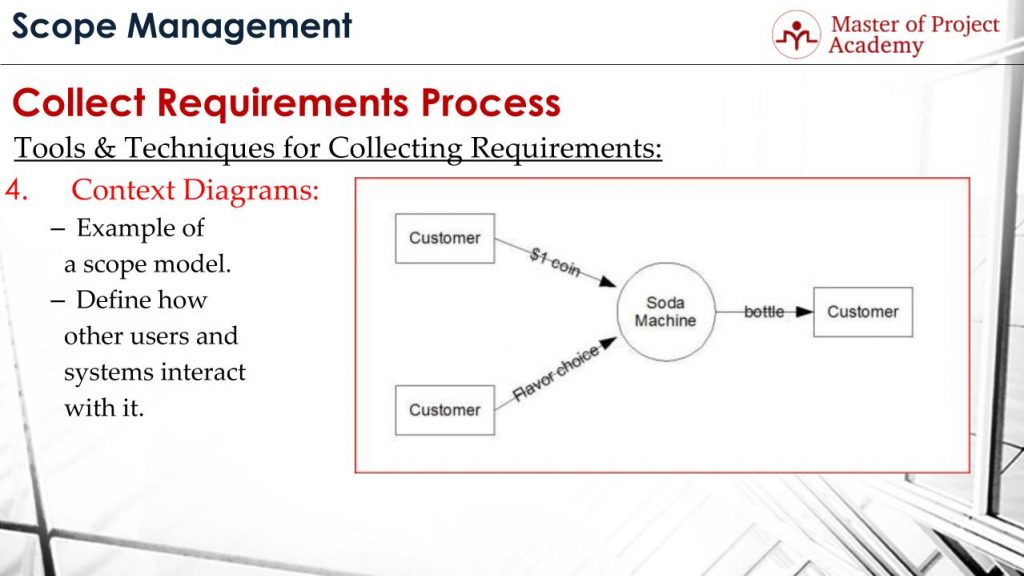
This figure shows a context diagram of how a soda machine works. As you see, customer first puts a $1 coin. Then he selects the flavor. Then the soda machine gives the bottle to the customer.
Collect Requirements Process Technique #15: Document Analysis
In the last collect requirements process technique called Document Analysis, existing documents are used to elicit requirements for the project. For instance, let’s consider that Apple will produce a new smartphone version. Existing documents of older smartphone versions will be a basis for generating requirements for the new smartphone. Therefore, business plans, agreements, requests for proposals, application software documentation, use cases and many more documents can be the source for generating requirements if you are using Document analysis technique.
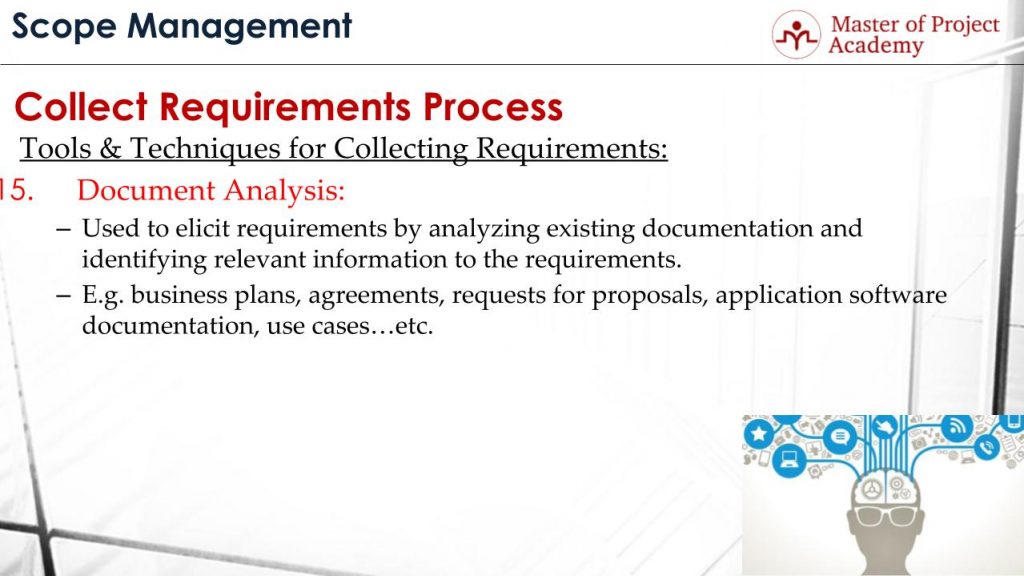
We have explored all fifteen collect requirements techniques in scope management knowledge area. In short, collect requirements is an important process because if the requirements from the stakeholders are not collected properly, the scope of the project may risk being faulty. Suitable techniques to collect requirements should be selected and implemented by the project manager in order to have a successful scope management.
Review by: Jean Coleman



3 thoughts on “15 Tools & Techniques for Collect Requirements Process”
Comments are closed.